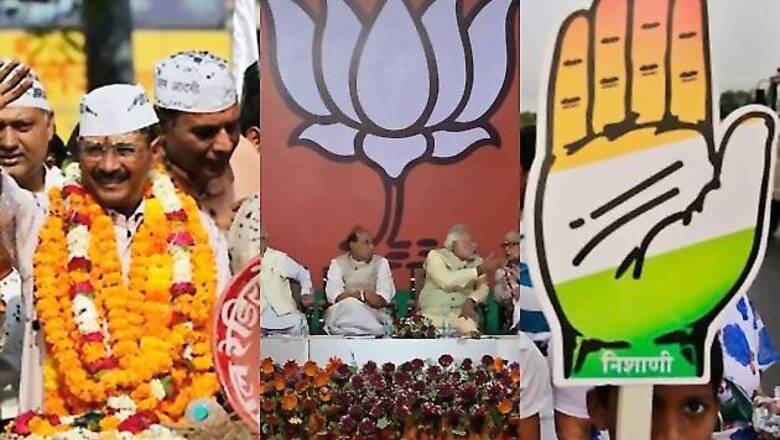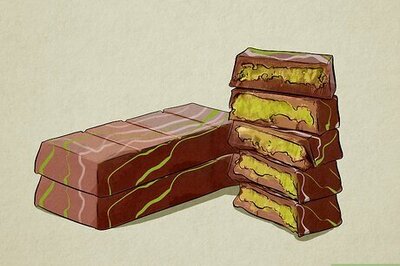
views
Like a well-used night shelter resting on high tectonic activity, Delhi itself seems to hold few surprises, save for the fact of ceaseless activity below the surface changing its visible form and contours. Its politics is as frequently misread as its weather - as being on the whole derivative. Perceived as a place where 70 per cent of its 160 million citizens regard it with detachment as their 'karmabhoomi' and not 'janmabhoomi', many believe Delhiites lack a deeper emotional connect with their domicile.
Which is why when Delhi became the laboratory of an audacious political experiment, where heavy doses of idealism reaped electoral dividends in the 2013 assembly elections, many wondered how a city shorn of any mass emotional connect could crave, then reward, idealistic change. Now, the seeds sown by AAP flower across the country, fuelling ambition, sensing opportunity. Some attribute the efflorescence to that one word everyone loves but few understand-change. Yet, many have misunderstood why Delhi rewarded Kejriwal's experiment.
Caste or religion isn't a determinant for voters in Delhi; class is. A staple in bigger states, the two factors do not unify or create any bloc big enough in Delhi to be exploited through the politics of victimhood. It's perhaps the only state where the rich, and the upper, middle and lower middle classes exist in virtually equal numbers. Their one commonality: most of them are migrants to the city, where they pursue the pared - down goal of leading a better, improved life.
- Aam Aadmi Party's surge has subsided; gap between BJP and AAP narrower. There is an anti - Congress mood in Delhi.
- BJP, AAP have selected candidates unwisely, thus Rajmohan Gandhi is pitted against Sandeep Dikshit in Delhi East. In New Delhi constituency, Ajay Maken has a chance because of a weak AAP candidate - journalist Ashish Khetan.
- Bhojpuri actor Manoj Tiwari being parachuted into Delhi North East has not gone down well with local BJP cadre.
- Rakhi Birla likely to be sole AAP winner in Delhi; Krishna Tirath and Udit Raj are considered weak candidates in Delhi North West
Even as migration kept gathering pace through the 1990s, the BJP kept failing to notice ground - level change, yielding ground to the Congress for the next 15 years. It also gave birth to the Congress strategy of creating notional "unifying support blocs" by regularising illegal colonies and slums - 'JJ clusters' in Delhi bureaucratese. The pitch was simple 'you were illegal; we've made you legal' - a strategy that won votes for the Congress. It gave birth to Sheila Dikshit's version of Swaraj - the Bhaagidari scheme - taken one step further by the AAP's idea of self-governing mohalla sabhas.
Most people from Delhi's low income category, as elsewhere, work for their economic superiors. Plumbers, electricians, cab drivers, housemaids, vendors, shop assistants and others make lives of the affluent easier. Their ability to send cash back home is linked to their employers' prosperity. It spawns a competitive job environment - a ceaseless jostling to make a buck faster than the man next door. This large segment of the electorate votes purely on what positively impacts or aids their own lives. In a city where power, privilege and money are openly flaunted, the poorer sections do feel left out. This felt deficit of privilege and economic empowerment is the reason why the AAP's discourse worked.
Politics thrives on a sense of victimhood; in Delhi, AAP dichotomised its poll pitch as a battle between an honest 'us' and a corrupt 'them', comprising the powerful and parties which pander to 'them'. It concocted a victimhood not rooted in caste or religion, but in lack of access, participation and privilege.
Delhi is electorally misjudged for another reason. The city - state doesn't just consist of Connaught Place, Jor Bagh, South Extension, Chanakyapuri, Defence Colony or Greater Kailash. Areas like Kapashera, Burari, Nand Nagri, Ambedkar Nagar, Karawal Nagar, Jaffrabad, Seelampur, Badli, Deoli, Rithala and Madipur houses millions of citizens whose needs and aspirations go unheard and undebated. They remain the blind spot in our commentary; areas we don't wish to see or pretend don't exist.
Residents in these areas - adding up to significant electoral numbers - mostly work to send remittances back home, and dream of joining the aspirational class. Like most dreams in modern India, they are in a hurry. So, the thought of a cheaper power bill, free water and a cooperative police found ready appeal with them. AAP knew it would be tough for them to bemoan the state of development and infrastructure in Delhi - one of India's most pampered states. After all, the roads, the Metro, the low - floor buses are there for all to see and use. Arguably, they are amongst the better ones on a comparative nationwide index. They therefore redefined and repackaged shortcomings for their target audience.
The privileged half in Delhi has confirmed western economists' favoured description - secession of the successful. Gated communities, power back-up, purchased water, access to private healthcare and high comparative incomes insulate them from many daily worries of the less privileged, who look to the government to provide them. The voting patterns of the upper classes are individualistic in some measure. They, too, can vote for instant, perceived benefits, not merely out of ideological convictions.
The hard pitch of immediate promises meant that once in power, AAP would always be judged by the success of their delivery. As we know, 49 days isn't enough time to decisively alter any landscape in governance. But charges of betraying its impressive mandate by being quitters have hit AAP thick and fast. Disillusionment spreads quickly; as Delhi reaches the last leg of campaigning, idealism fights a losing battle with the disappointment of not getting cheaper power and free water. If AAP faces persistent questions over its sudden exit, they are being harried not only because Delhiites miss the heady experience of a revolution, but because the hopes of material change lie in ruins. A large chunk of Delhi's electorate was also the beneficiary of the old compromised system; it's when the arbitrariness of patronage puts them on its wrong side that they feel the injustice of it.
In other states, politics follows different rules. Identity politics becomes a spur to victimhood; in many places, people are comfortable with political legacies and age - old allegiances to an ideology. States have hugely inconsistent development patterns and disconnect between urban and rural parts. Quite unlike Delhi, where the privileged and under-privileged live cheek-by-jowl and use the same infrastructure. In a city - state like Delhi with its very economic logic of cohabitation, it follows that issues of identity are less of a factor. There may be more cars on the roads here. But the disaffection in not being part of the growth story is the same everywhere.
That's why it must be remembered that Delhi isn't a lab which allows tests in standard temperature and pressure (STP) conditions. Why, India or even Delhi itself isn't thinking the way it was in December last year!
(This article earlier appeared in Outlook magazine)
















Comments
0 comment